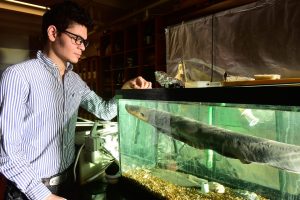 A major metabolic stressor to all aerobic organisms is low oxygen, or hypoxia, which can lead to cell death. Some animals have evolved the ability to adapt to this stress, but the mechanisms remain largely unknown.
A major metabolic stressor to all aerobic organisms is low oxygen, or hypoxia, which can lead to cell death. Some animals have evolved the ability to adapt to this stress, but the mechanisms remain largely unknown.
This evolutionary enigma prompted PhD student Ahmed Elbassiouny to investigate how specific electric fish species evolved to survive and thrive for long periods in low-oxygen conditions. His results from work in the Lovejoy and Chang labs were published as “Evolution of a novel regulatory mechanism of hypoxia inducible factor in hypoxia-tolerant electric fishes“.
Some electric fish in the genus Brachyhypopomus live in low-oxygen waters known as ‘dead zones’. These species have evolved to tolerate hypoxia in their murky homes and even anoxia—complete oxygen depletion—for entire seasons, while their sister species in clearer waters have not.
Comparing closely related hypoxia-tolerant and -intolerant species allows the researchers to home in on what exactly is responsible for this difference.
Hypoxia inducible factor (HIF) is known as the ‘master regulator’ of hypoxia tolerance thanks to its ability to activate genes used in anaerobic metabolism. After analyzing the evolution of HIF genes across fish species, the researchers singled out the HIF1α subtype as a likely target for hypoxia adaptive evolution.
Elbassiouny used the novel approach of inserting Brachyhypopomus HIF genes into human cell lines using CRISPR-Cas9. This easily manipulated system was used for assays to measure and compare HIF1α activation.
He found HIF1α from hypoxia-tolerant species was present at higher levels than HIF1α from hypoxia-intolerant species in both normal and low oxygen conditions, presumably leading to increased activation of HIF1α targets. The tolerant HIF1α gene had higher expression, but this was unexpectedly combined with increased protein stability due to mutations that favoured interactions with other protein domains.
Altogether, the interrogation of hypoxia-tolerant HIF1α revealed mutations and post-translational interactions that increased protein levels and stability, favouring an increase in anaerobic metabolism in response to hypoxia.
Part of the reason for the hypoxic condition of tolerant Brachyhypopomus’ home is its temperature: the water is intolerably warm to other fish, but beneficial for the growth of algae. Bacterial growth fed by algae depletes aquatic oxygen levels, with extreme examples leading to dead zones.
Organisms remaining in dead zones must be able to tolerate hypoxic and anoxic conditions. This creates evolutionary pressure to develop increased hypoxia tolerance. Elbassiouny has shown this increased tolerance is partially mediated through increased expression and stability of HIF1α.
For more on this paper, and how these results affect our understanding of cancer, read “No oxygen? No problem” by Marissa Locke Rottinghaus.
